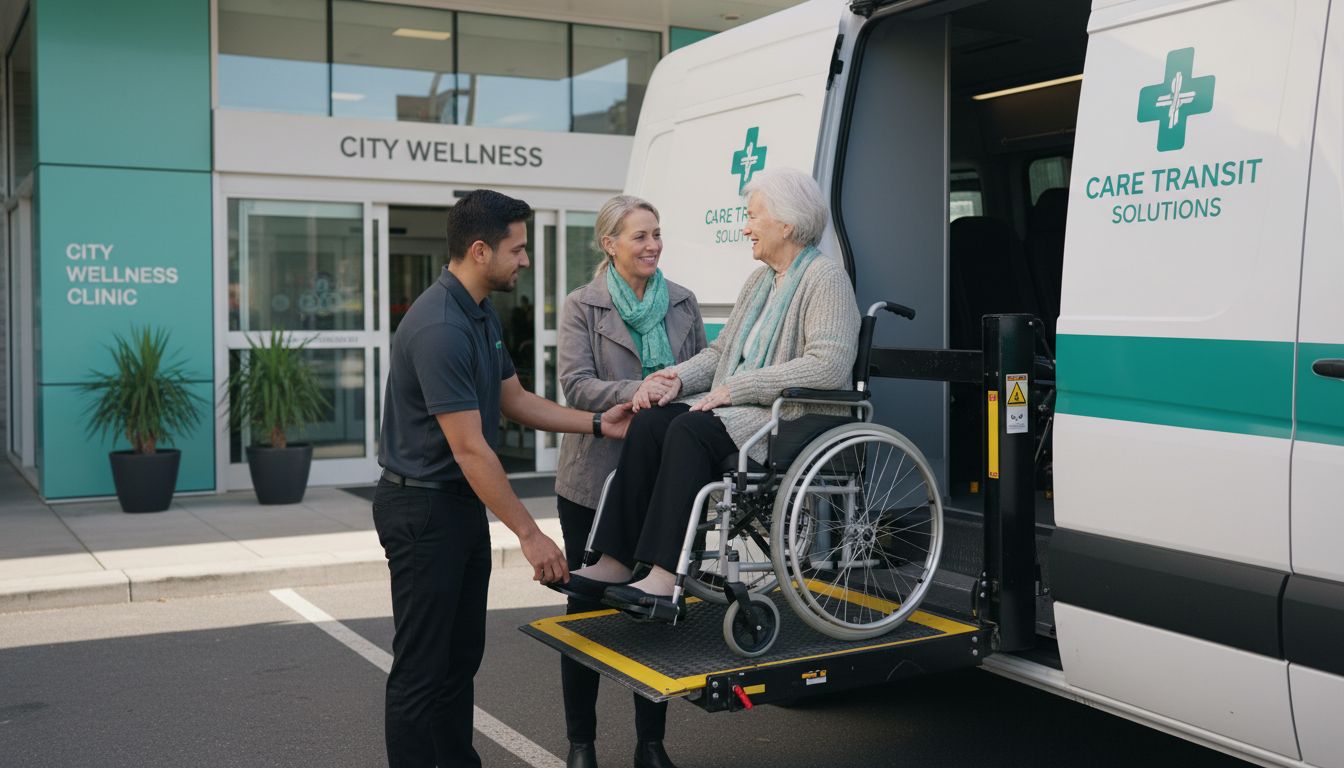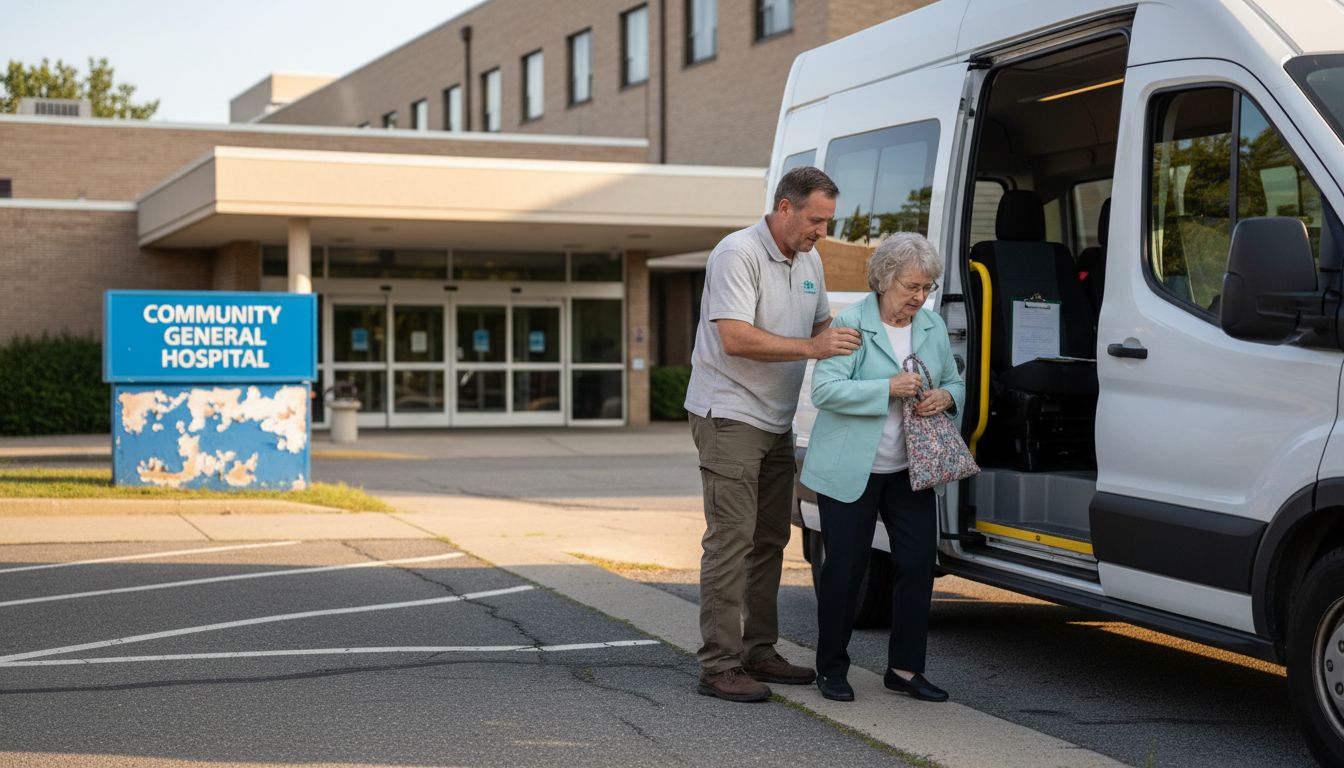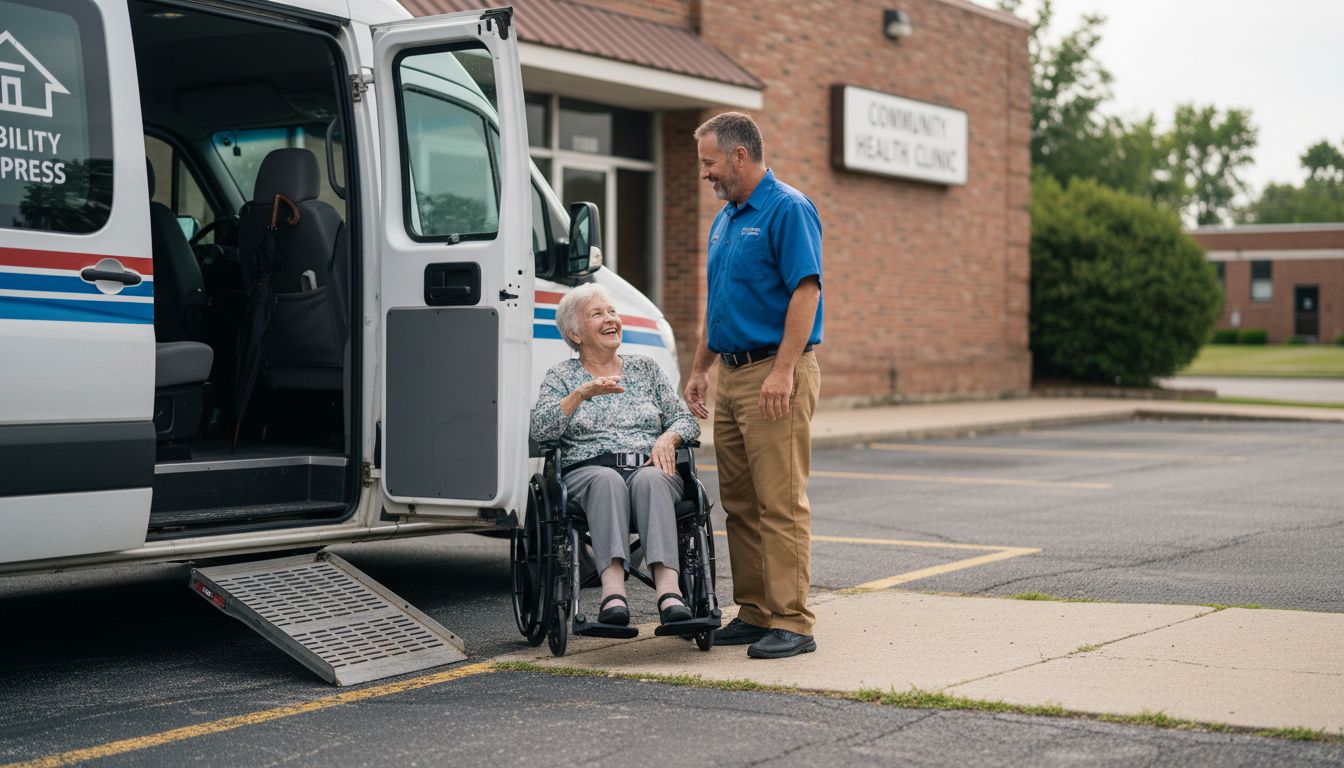Complete Guide to Non Emergency Medical Transportation Services

Did you know that millions of Americans depend on non-emergency medical transportation each year to reach essential healthcare appointments? Reliable access to care can be a challenge for people without cars, those with mobility issues, or individuals managing chronic health conditions. Understanding how these transportation services work, the types available, and the rules guiding them can make a difference in making sure no patient misses out on needed treatment.
Table of Contents
- Defining Non Emergency Medical Transportation Services
- Types of Non Emergency Medical Transport Solutions
- How NEMT Services Operate and Integrate
- Legal and Compliance Standards in NEMT
- Costs, Reimbursement, and Operational Implications
- Selecting and Managing NEMT Providers Effectively
Key Takeaways
| Key Point | Details |
|---|---|
| Essential NEMT Service | Non-emergency medical transportation (NEMT) is a vital service enabling patients without alternative transport to access necessary medical care. |
| Types of NEMT Solutions | NEMT encompasses various transportation modes, including wheelchair vans, stretcher options, and taxi services, tailored to patient needs. |
| Operational Framework | NEMT services operate through complex models involving coordination between healthcare providers, transportation vendors, and state Medicaid programs. |
| Compliance Requirements | NEMT services must adhere to strict legal and compliance standards, including patient eligibility verification and safety regulations. |
Defining Non Emergency Medical Transportation Services
Non-emergency medical transportation (NEMT) represents a critical healthcare support service designed to help patients access medical care when traditional transportation methods are unavailable. According to Macpac, NEMT is a required Medicaid benefit specifically created to provide transportation to and from medical appointments for enrollees who lack alternative transportation options.
At its core, non-emergency medical transportation serves patients who cannot independently travel to necessary medical services. This might include individuals with mobility challenges, seniors, patients with chronic conditions, or those without personal vehicles or financial means to arrange transportation. Centers for Medicare & Medicaid Services emphasizes that NEMT is an essential benefit ensuring beneficiaries can reliably reach critical healthcare services.
Key characteristics of non-emergency medical transportation services typically include:

- Scheduled, pre-arranged transportation
- Specialized vehicles equipped for medical needs
- Trained drivers understanding patient care requirements
- Door-to-door or door-through-door assistance
- Wheelchair and stretcher-accessible transportation options
Understanding what is non-emergency patient transport can help healthcare providers and patients navigate these essential mobility services more effectively, ensuring no individual is prevented from receiving necessary medical care due to transportation limitations.
Types of Non Emergency Medical Transport Solutions
Non-emergency medical transportation offers a diverse range of transportation solutions designed to meet various patient mobility needs. Centers for Medicare & Medicaid Services highlights that NEMT services encompass multiple transportation modes, including taxis, buses, vans, and personal vehicles, each tailored to address specific patient requirements.
Wheelchair Accessible Vehicles represent a critical component of non-emergency medical transport. These specialized vehicles are equipped with hydraulic lifts, secure wheelchair restraints, and trained drivers who understand the unique needs of patients with mobility challenges. National Conference of State Legislatures confirms that wheelchair vans are a fundamental transportation option ensuring accessibility for beneficiaries with diverse mobility requirements.
The primary types of non-emergency medical transportation solutions include:
Here’s a summary of the main types of non-emergency medical transportation solutions:

| Transportation Type | Typical Use Case | Key Features |
|---|---|---|
| Wheelchair Vans | Patients with mobility impairments | Hydraulic lifts Wheelchair restraints Specialized drivers |
| Stretcher Transportation | Patients unable to sit upright | Stretcher access Medical oversight Extra space |
| Taxi Services | Ambulatory patients with minimal needs | Flexible Cost-effective No special equipment |
| Public Transit Assistance | Patients needing extra support on transit | Coordinated rides Travel assistants Accessible routes |
| Personal Vehicle Reimbursement | Patients with personal vehicles | Mileage reimbursement Flexible scheduling |
- Wheelchair Vans: Fully accessible vehicles with lift systems and secure restraints
- Stretcher Transportation: Specialized vehicles for patients unable to sit upright
- Taxi Services: Economical option for ambulatory patients with minimal assistance needs
- Public Transit with Assistance: Coordinated transportation services with additional support
- Personal Vehicle Reimbursement: Programs allowing patients to use personal vehicles with mileage compensation
Understanding non-emergency transport ambulance services can provide additional insights into how healthcare systems strategically deploy various transportation solutions to ensure comprehensive patient mobility and access to critical medical care.
How NEMT Services Operate and Integrate
Non-Emergency Medical Transportation (NEMT) services operate through complex, strategic frameworks designed to ensure efficient patient mobility. Macpac reveals that states deliver these services through multiple operational models, including third-party brokers, fee-for-service arrangements, and managed care plans, each with unique approaches to coordinating transportation.
The core operational mechanism typically involves sophisticated coordination between healthcare providers, transportation vendors, and patient management systems. Medical Transportation Access Coalition highlights that many states leverage specialized transportation brokers to manage NEMT services, focusing on optimizing both impact and cost-effectiveness within their Medicaid programs. These brokers act as central coordinators, matching patient needs with appropriate transportation resources.
Key operational components of NEMT services include:
- Patient Eligibility Verification: Screening and confirming transportation assistance requirements
- Transportation Routing: Optimizing vehicle assignments based on patient needs
- Scheduling and Dispatch: Coordinating precise pickup and drop-off times
- Real-Time Tracking: Monitoring transportation progress and ensuring patient safety
- Billing and Reimbursement: Managing financial transactions between service providers
Understanding NEMT services provides deeper insights into the intricate ecosystem that enables seamless medical transportation, ensuring patients receive timely and appropriate transit support for their healthcare needs.
Legal and Compliance Standards in NEMT
Non-Emergency Medical Transportation (NEMT) operates within a complex legal framework designed to protect patient rights and ensure consistent healthcare access. Centers for Medicare & Medicaid Services mandates specific compliance requirements through the Code of Federal Regulations, which outline the fundamental legal obligations for transportation services provided to Medicaid beneficiaries.
State Medicaid programs bear significant responsibility for implementing these transportation benefits. National Conference of State Legislatures confirms that states are required to provide necessary transportation to and from healthcare providers as a mandatory Medicaid benefit. This legal mandate ensures that patients with limited mobility or financial resources can access critical medical services without transportation barriers.
Key legal and compliance standards for NEMT services include:
- Patient Eligibility Verification: Strict protocols for determining transportation assistance qualifications
- Privacy Protection: Compliance with HIPAA regulations for patient information
- Vehicle Safety Standards: Meeting federal and state transportation safety requirements
- Non-Discrimination Policies: Ensuring equal access regardless of patient characteristics
- Fraud Prevention: Implementing robust mechanisms to prevent misuse of transportation benefits
Reduce NEMT Fraud with VectorCare Hub offers additional insights into maintaining legal integrity and preventing potential compliance violations in non-emergency medical transportation services.
Costs, Reimbursement, and Operational Implications
Non-Emergency Medical Transportation (NEMT) represents a complex financial ecosystem with intricate cost management strategies. Macpac reveals that states have developed sophisticated approaches to managing NEMT expenses, including implementing cost-sharing measures such as nominal copayments and strategically limiting the number of permitted trips to control overall spending.
Centers for Medicare & Medicaid Services highlights that Medicaid reimbursement structures for NEMT providers are highly variable, depending on state-specific regulations and unique delivery models. These reimbursement mechanisms are designed to balance fiscal responsibility with ensuring comprehensive patient transportation access.
Key financial and operational considerations in NEMT include:
- Cost Allocation: Precise tracking of transportation expenses per patient
- Reimbursement Modeling: Developing flexible payment structures
- Operational Efficiency: Minimizing administrative overhead
- Risk Management: Preventing fraudulent transportation claims
- Budget Optimization: Balancing service quality with cost constraints
8 Key Insights on Non Emergency Ambulance Transport Cost provides additional context for understanding the nuanced financial landscape of medical transportation services.
Selecting and Managing NEMT Providers Effectively
Non-Emergency Medical Transportation (NEMT) provider selection is a critical process that demands strategic evaluation and comprehensive assessment. Centers for Medicare & Medicaid Services highlights that states typically utilize competitive bidding processes to contract transportation brokers, ensuring rigorous provider qualifications and compliance with stringent Medicaid standards.
The provider selection process involves multiple layers of sophisticated screening and ongoing performance monitoring. Medical Transportation Access Coalition emphasizes that specialized transportation brokers play a crucial role in managing NEMT services, focusing on optimizing operational impact and cost-effectiveness within complex healthcare delivery systems.
Key considerations when selecting and managing NEMT providers include:
- Compliance Verification: Ensuring adherence to federal and state regulations
- Safety Record Evaluation: Reviewing driver qualifications and vehicle maintenance standards
- Technology Integration: Assessing capability for real-time tracking and reporting
- Patient Experience Metrics: Analyzing historical performance and customer satisfaction
- Cost-Effectiveness Analysis: Comparing pricing structures and operational efficiency
How to Choose the Right NEMT Provider provides additional strategic insights for healthcare organizations seeking to optimize their non-emergency medical transportation partnerships.
Enhance Your Non Emergency Medical Transportation with VectorCare
The “Complete Guide to Non Emergency Medical Transportation Services” highlights the complex challenges of coordinating efficient, compliant, and patient-centered medical transportation. From managing specialized vehicles like wheelchair vans to ensuring timely scheduling and verifying patient eligibility, healthcare organizations face considerable operational hurdles that can delay care and increase costs. VectorCare understands these pain points and offers an integrated platform that transforms these challenges into streamlined opportunities through AI-driven dispatching, real-time tracking, and vendor management.
Transform your patient logistics with a system designed to reduce delays and operational burdens across all NEMT types. Whether coordinating stretcher transports, wheelchair accessible vehicles, or public transit assistance, VectorCare delivers comprehensive tools for better scheduling, compliance, and communication.
Unlock the full potential of your non emergency medical transportation services today and experience tangible improvements in patient care and cost efficiency.

Ready to overcome the complexities of NEMT and elevate your healthcare operations? Explore how VectorCare’s platform can help you automate processes and ensure reliable transportation for every patient. Learn more at VectorCare’s homepage and start optimizing your patient logistics now.
Frequently Asked Questions
What is Non-Emergency Medical Transportation (NEMT)?
Non-Emergency Medical Transportation (NEMT) is a healthcare support service that assists patients in getting to medical appointments when other transportation means are not available. It is a required Medicaid benefit designed for those without alternative transportation options.
Who qualifies for NEMT services?
Individuals with mobility challenges, seniors, chronic condition patients, or those without personal vehicles or the financial means to arrange transportation typically qualify for NEMT services. Each state may have its eligibility criteria under their Medicaid programs.
What types of vehicles are used for NEMT?
NEMT services utilize a variety of vehicles, including wheelchair accessible vans, stretcher transportation, taxis for ambulatory patients, public transit with assistance, and personal vehicle reimbursement options, each tailored to meet specific patient needs.
How do NEMT services operate?
NEMT services operate through coordinated frameworks involving healthcare providers, transportation vendors, and patient management systems. Many states use transportation brokers to ensure efficient service delivery, while key components include patient eligibility verification, scheduling, dispatch, and real-time tracking.



